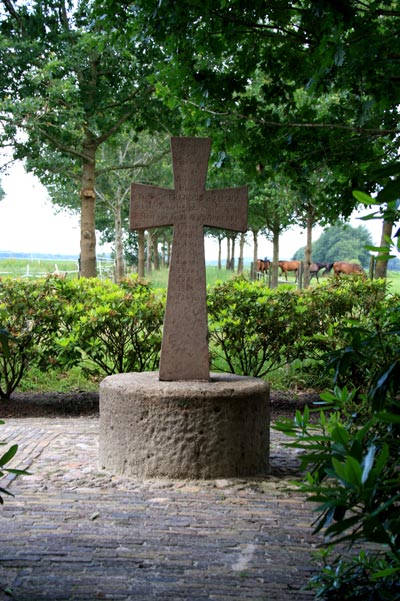Introduction
In May, 1940 the Luftwaffe took over the captured Dutch airfields. They were soon enlarged in the framework of the war against Great Britain. At first, only two new airfields were constructed: Volkel in North-Brabant and Peest in North-Drenthe near Norg. The last one was ultimately not used due to the ground water of the place. Only in the end of 1942 was construction started of a third new airfield, at Havelte in Southwest-Drenthe.
To the east of Steenwijk and north of Havelte lie remnants of the once mighty Fliegerhorst Havelte. A Fliegerhorst was in the Luftwaffe a large airport that was fully equipped for all sorts of airplanes. Between the forests and heaths still lie blown up bunkers, a dug under communications bunker at a children's playground, a water well for the fire brigade and houses built in the Heimatschutzstil near the former entrance of the airfield. The former runway runs from west to east over 1,400 meters and is 80 meters wide. Nowadays it ends in a golf course. The runway is situated right north of the post war neighbourhood De Meerkamp in Havelte. The bombs that were placed by the Germans in the runway in order to blow up the runway when they had to retreat, only were defused in the beginning of the nineties of the last century. Nowadays the former runway is covered with trees and groves. Before the new neighbourhood could be constructed, unexploded bombs were removed by the explosives removal unit, the EOD.
From October,1942 onwards the German occupier built a completely equipped airfield for all types of aircraft, a Fliegerhorst, on 600 hectares or around 900 soccer fields on the Drenth heath near Havelte. Four thousand forced labourers or contract workers, 20 million guilders, a same amount of paving bricks and ten kilometers of narrow gauge railway were deployed. Money, sweat nor labourers were spared. After the war, 36 locomotives and 745 freight lorries were found on the terrain.
Over 80 km of trenches were dug. Around 30 Flak positions and machine gun nests were constructed. Twenty hangars, 51 accomodations and 15 car boxes were built. The military presence varied from 150 to 700 men. All buildings were connected to the sewers, which was a novelty at the time for that area.
Earthenwork draining tubes can still be found. A few hangars with high earthen walls, the so called Ypenburg halls are still well visible. Former taxi ways or Rollbahnen are conspicuous because they are broader than normal paths. On the Kolonieweg, a former Rollbahn that was narrowed after the war, one can still see the "broodjes", the paving bricks. The area is littered with 2,000 bomb craters. On the edge of the Van Helomaweg southwest of the former airfield is a cross of sandstone that commemorates a French pilot, First Lieutenant F.R.M.F. baron Picaud de Moras d’Aligny, 24 years of age, who was shot down here on 7 April, 1945 and who died in his Spitfire IX.
Definitielijst
- brigade
- Consisted mostly of two or more regiments. Could operate independently or as part of a division. Sometimes they were part of a corps instead of a division. In theory a brigade consisted of 5,000 to 7,000 men.
- Flak
- Flieger-/Flugabwehrkanone. German anti-aircraft guns.
- Luftwaffe
- German air force.
- machine gun
- Machine gun, an automatic heavy quick firearm.
Images
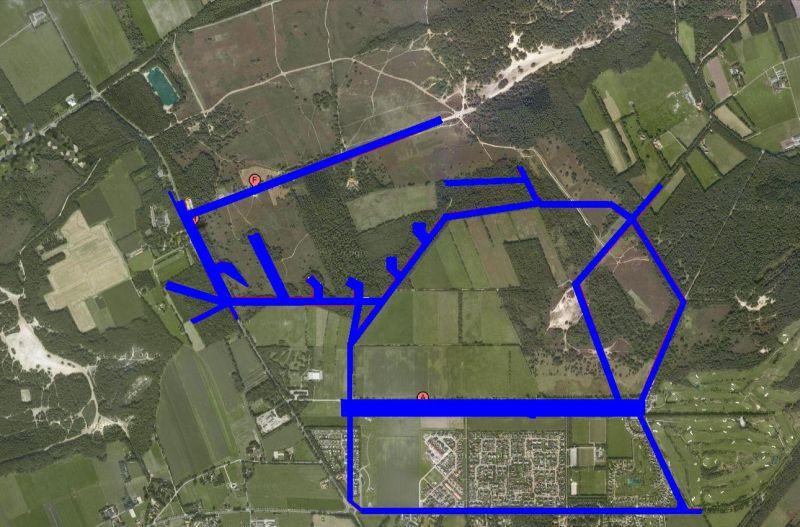 The infrastructure of the airfield. The second runway is not marked.The main runway is situated from west to east, is 1400 meters long and 80 meters wide. Source: Peter ter Haar / Google Maps.
The infrastructure of the airfield. The second runway is not marked.The main runway is situated from west to east, is 1400 meters long and 80 meters wide. Source: Peter ter Haar / Google Maps.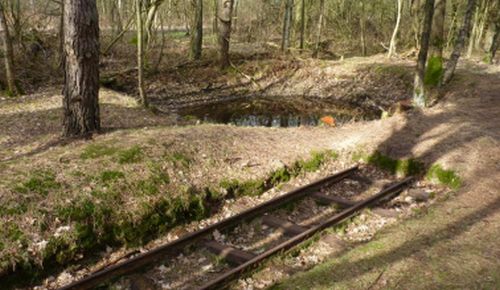 Remains of the German airfield. Railway and crater. Source: Ab Logtmeijer.
Remains of the German airfield. Railway and crater. Source: Ab Logtmeijer.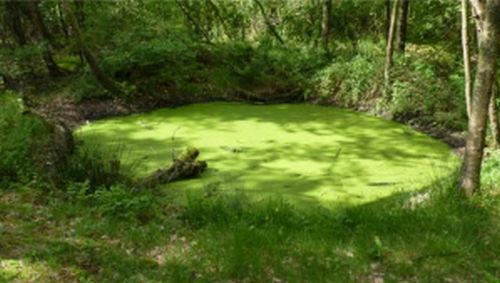 Crater next to the railway. Source: Ab Logtmeijer.
Crater next to the railway. Source: Ab Logtmeijer.Location, preceding history and construction
Near the village of Havelte near Steenwijk the Germans built an airfield. This was decided because there was a hole between the airfields of Leeuwarden and Twente. The Germans needed a place of refuge for emergency landings or for when the other airfields were bombed. The Germans needed this because the attacks from the British Bomber Command and American Mighty Eighth or Eighth Air Force on their cities and industry were gaining in strength and frequency. For many years, bombing Germany was the most important way for the western allies to hit the Germans. Important targets were, next to the Ruhr area, the harbours, shipyards and industrial areas on the North-German coast like Bremen and Hamburg. Great Britain alone spent 40 % of its war effort on the bombing campaign. Besides, an extra night fighter base was needed next to Leeuwarden, Schiphol ( which was also the Leithorst or flight control base) and Twente. Havelte was situated favourably between these three airfields.
In October, 1942, construction of the airfield was started in the utmost secrecy. At first, the 1,400 meter long and 80 meter wide runway was known as Nachtlandeplatz Steenwijk or night landing place Steenwijk.
The ground of the former airfield is sandy and contains boulder clay and it lies quite high, at 17,5 meters above sea level. Very near is the Drentse Hoofdvaart or main canal that was used to transport the ships with the bricks and other building materials. As was mentioned earlier, a narrow gauge railway was constructed, among others for the transportation of sand and bricks. A branch was added from the normal railroad from Steenwijk to Meppel from the Staats Spoorwegen or the Dutch railroad company. This line was called the "Tom Poes lijn ". The NSB, the Dutch nazi party, mayor J.P. de Lang of Steenwijk, was a man with a short and squatty posture, hence the nickname.
A camp near the present location of the hunebedden or dolmens housed the prisoners from the Rijkswerkinrichting, a prisoner work system, from Veenhuizen and Groningen, and Jews that had been put to forced labour. These Jews had not been deported because they were from mixed marriages. Among them was the well known violin player Benny Behr. The German-Dutch mathematician and pedagogue Hans Freudenthal was also imprisoned here. The camp also housed prisoners that were put to work from Veenhuizen that had been quartered in barracks. There were other camps. The German authorities frequently performed razzias in order to recruit forced labourers. On the Helomaweg a camp was built that housed 1,000 labourers. Another camp lay on the Konijnenberg. Yet another camp existed near the church in Havelte, which itself functioned as a beacon for German pilots. Steenwijk was, by the way, the only place in the Netherlands where a razzia happened specially aimed at women. These were,however, not deployed on the airfield but at the Kornput barracks in Steenwijk to do all sorts of chores and to help in the lazaret in the barracks. In all, at the peak of construction, a total of 5,600 Dutch worked at the same time on the construction of the airfield. The hunebedden or dolmens were buried on the spot because they could serve as points of orientation for allied crews. After the war they were dug up and reconstructed in their original form. The garrison of the airfield varied considerably, between 150 and 700 men. This had to do with the verlegbare or transportable units of Flak and fighters and other Luftwaffe units.
The village of Darp (also Derp) was broken down and rebuilt to the west on the current location. The airfield was a real Fliegerhorst, including a Fliegerhorstkommandantur with machine gun troops, a completely equipped airfield that could sustain operations for longer periods of time. There was even a brothel for the Luftwaffe troops.
A local resistance fighter, Jan Poortman, took pictures of the construction of the airfield at the risk of his own life. Around 1942 he joined the resistance. He became district leader and went under the pseudonym Chris Senior, as head of the Route Noord of the Secret Service Netherlands (GDN), N 105, to collect information for the Central Intelligence Service - later the Bureau of Intelligence. He provided information about the progress of the construction of a military airfield near Havelte.
Definitielijst
- Bomber Command
- RAF unit which controlled strategic and sometimes tactical bombing (as in Normandy)
- Flak
- Flieger-/Flugabwehrkanone. German anti-aircraft guns.
- Jews
- Middle Eastern people with own religion that lived in Palestine. They distinguished themselves by their strong monotheism and the strict observance of the Law and tradition. During World War 2 the Jewish people were ruthlessly persecuted and annihilated by the German Nazis. . An estimated 6,000,000 Jews were exterminated.
- Luftwaffe
- German air force.
- machine gun
- Machine gun, an automatic heavy quick firearm.
- nazi
- Abbreviation of a national socialist.
- NSB
- National Socialist Movement. Dutch political party sympathising with the Nazis.
- razzia
- Organised round-up of a group of people. This could be Jews but also persons in hiding or other groups.
- resistance
- Resistance against the enemy. Often also with armed resources.
Images
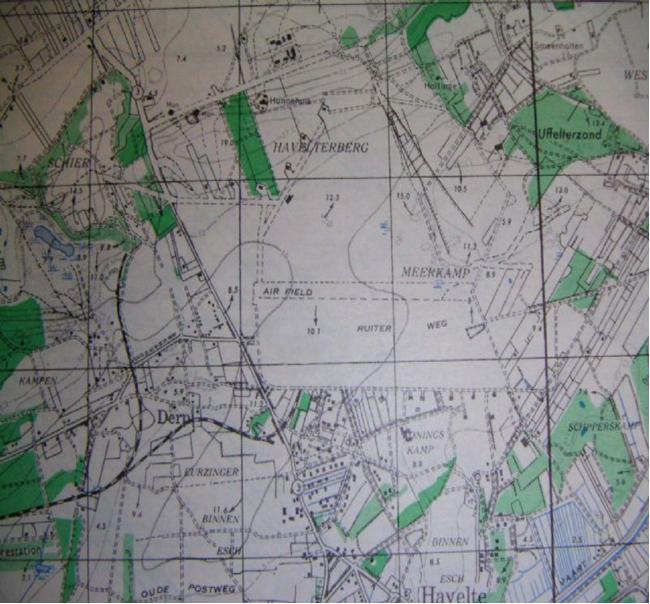 Allies map of the airfield. Clear visible is the 1400 meters long runway (see the word: airfield). The so called "Tom Poes" railway is visible in black and white. In the left upper quadrant, next to the word Mon, a black spot indicates the two dolmens. Source: Peter ter Haar.
Allies map of the airfield. Clear visible is the 1400 meters long runway (see the word: airfield). The so called "Tom Poes" railway is visible in black and white. In the left upper quadrant, next to the word Mon, a black spot indicates the two dolmens. Source: Peter ter Haar.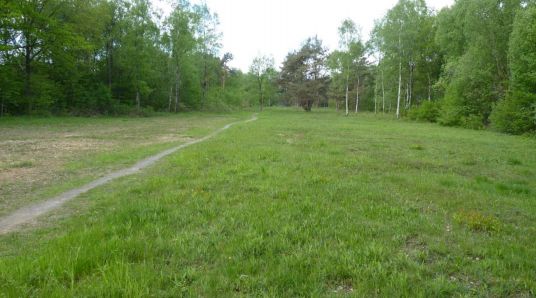 Runway anno 2012. Source: Ab Logtmeijer.
Runway anno 2012. Source: Ab Logtmeijer.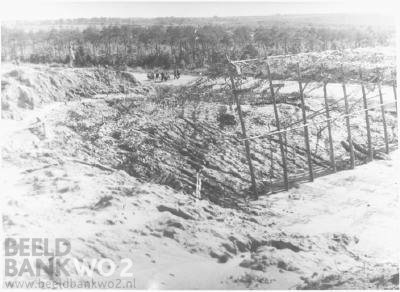 Camouflaged aircraft storage next to the airfield. Source: Beeldbank WO2.
Camouflaged aircraft storage next to the airfield. Source: Beeldbank WO2.Acts of war on the airfield
While the work proceeded the airfield drew more and more the attention of the allied intelligence services. It became an occasional target for dropping bombs when a bomber had not dropped its payload for whatever reason.
In the book "Mission 376-Battle over the Reich-May 28, 1944", on page 290 is described:
Only two Liberators in the combat wing had mechanical problems. Bugs Bunny, flown by Lieutenant Wescott, of the 467th Bomb Group had a failing supercharger and returned home. Wescott decided not to take back the bombs to England and chose the airport at Havelte, 8 kilometers north of Meppel, as target of opportunity for his ten 500 lb bombs.
An American wireless operator and nose gunner, Technical Sergeant Frederick Gerritz, describes a mission from the 466th Bombardment Group (Heavy) on 15 Augustus, 1944. That day there had been an attack on Vechta, 50 kilometers southwest of Bremen, the location of an airfield from which the feared Messerschmitt 262s operated. This attack was part of a large operation of the allied air forces against the Luftwaffe. Spread out over the whole of North-west Europe 2,000-3,000 airplanes attacked the German airfields. "Our flight to Vechta went without problems and we bombed the airfield without incidents. Everybody was in a good mood and we were heading back when we were suddenly attacked by Me 109's. They came out of nowhere. They attacked with the sun in their backs. I heard later that they had rockets (Pulk Zerstörer, "formation destroyer" 21 cm Wurfgranate weighing 40 kgs-translator). They had flown straight through the formation in order to attack us."
The B-24 Liberator ("No Feathered Engines") was hit and Gerritz hurried out of the plane. A few seconds later the heavy bomber exploded.
"From the west, at the same altitude, a black fighter headed toward me. This meant that it was an enemy. The decisive passage of the aircraft was a matter of seconds. I waved at the pilot while he roared past me. Then it became clear why he was in such a hurry: at a short distance, right in his trail, was a P -38 Lightning chasing him.
The Lightning managed to shoot the German out of the skies. A short while later, Gerritz hit the ground. He freed himself from his parachute.
"When I looked around I saw something shocking: at a short distance to the south German fighters were landing. There lay the German air base( Havelte- translator) where the German planes had taken off to attack us."(sic)
Gerritz was ultimately found by the resistance and managed to evade capture. He would survive the war.
A German after action report says among others:
"On 15 August, 1944, beginning 11:50 hour, strong formations of enemy heavy bombers that were partlially escorted by fighters flew over the airfield of Steenwijk at an altitude of 5,000-6,000 meters from east to west. At 13:04 hour, from the south came two groups of Bf 109’s, went into attack position and attacked an enemy formation right over the airfield. The formation was without fighter escort and was on its way back home. In a few minutes of the attack, which was carried out with great vigour, the enemy formation was dispersed respectively destroyed. Numerous four-engined machines, around eight to ten, besides some of our own fighters went down. Twenty to thirty enemy crew members went down with their parachutes. After executing the attack the Bf 109's started to land."
The American Lightnings suddenly appeared from the west and attacked the recently landed Germans. A German that had just landed on the runway was shot at by a P -38. The pilot managed to get out of his plane and to evade the rain of bullets from the American. The aircraft also survived this action and could later take off again. The pilot was Leutnant Ernst Scheufele, 20 years old.
The German report continues:
"The enemy machines got, for the first time at 13:09 hour, within the effective range of the Flak weapons and were very effectively shot at. By numerous well placed hits the Lightnings were brought in the destruction zone and three of them were shot ablaze."
In the diary of another survivor, Lieutenant R.K. Borst, we read what happened:
"The sight over the North- Netherlands was good and there was no trace of the enemy to be seen. Slowly the Americans became off guard and started to doze a little: the worst was over after all. Bomb Group 466 reached Havelte and there it happened! Twenty German fighters flew beneath the American formation and these were dropping everywhere. The men who died there will never know what hit them. At first everybody thought the Germans had committed their Me 262 for the first time but this did not turn out to be the case. The airfield (Havelte) was not equipped for these giant machines because the runways were too short. The Germans had assembled rockets under the wings of the Me109 fighters. Under the tremendous roar of these rockets the Germans could take off fast and fairly quick one after the other and attack the American formation from beneath and disperse them. The consequences for Bomb Group 466 were terrible. Burning and broken into pieces the airplanes fell down."
It seems that the "starting rockets" were the WG21 Wurfgranate 21cm. These tubes with the Wurfgranaten were called Startrohr. It is in fact a tube with a rocket propelled grenade. This start was for the Wurfgranate and not a device to take off quickly. It seems that the above story was born in the heat of battle and that the story was confused by rumours and time.
Harry A. Clark was in the B-24 with nickname Stardust:
"At 13:00 hour Bob Lehman reported Me-109 fighters and he tried to shoot them but without succes. The Germans came back from the right and fired some more volleys. One of the fighters was hit and crashed, followed somewhat later by a second one. The Stardust shot down two Germans. The total number of destroyed enemy fighters was ten (sic)."
A short while later the Liberator was fatally hit. Four out of ten crew members managed to bail out of the aircraft and landed unscathed. The Bf-109G6 crashed nearby. Unteroffizier Rudolf Schierhofer, 21 years old, 6./Jagdgeschwader 5, the sixth Staffel from Jagdgeschwader 5 ( Eismeer) landed safely although he broke a leg. He had taken off from the Salzwedel base, 60 km south-east of Lüneburg. Other sources mention the Sachau base, south-west of Gardelegen. Oberfähnrich Horst Starzinski, 20 years,of the same unit was found dead. His parachute had failed to open.
"True Love" had shot down two fighters. Then her luck ran out. The aircraft exploded in the air and came down in all kinds of smaller pieces: the engines,the tail, a gun cupola, a part of the tail with the cupola in which the killed tail gunner was found. The entire surroundings was scattered with equipment: pilot jackets, pilot caps and boots, bandages, a rubber boat with paddle, flak vests, oxygen bottles, 50cal cartridge belts, etcetera.
Five out of ten crew members died, four were taken prisoner and one managed to escape. One of the captives, door gunner H.A. Clark, had his name changed after returning from Europe in H.A. Dolph(!) In 1989 and 1994 he was in Holland again where he also met a German pilot, Leutnant Ernst Scheufele who was involved in the same fight and who we met earlier.
Definitielijst
- destroyer
- Very light, fast and agile warship, intended to destroy large enemy ships by surprise attack and eliminating them by using torpedoes.
- Flak
- Flieger-/Flugabwehrkanone. German anti-aircraft guns.
- heat
- High-explosive anti-tank warhead. Shaped charge projectile to punch through armour. Used in e.g. bazooka or in the Panzerfaust.
- Luftwaffe
- German air force.
- resistance
- Resistance against the enemy. Often also with armed resources.
- rocket
- A projectile propelled by a rearward facing series of explosions.
Images
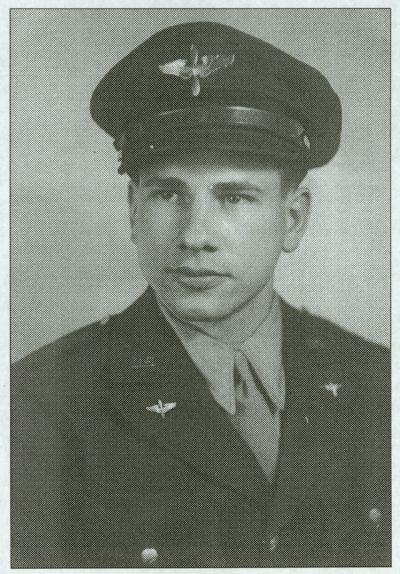 Technical Sergeant Frederick Gerritz, whose B-24 Liberator crashed near the German airfield Havelte. Source: Library of Congress.
Technical Sergeant Frederick Gerritz, whose B-24 Liberator crashed near the German airfield Havelte. Source: Library of Congress.Bombardments
After 15 Augustus, 1944 it was clear that the airfield was fully operational.This was the reason for the attacks on 4,5 and 17 September 1944. On 4 and 5 September, 8 ton of ordnance was dropped at the airfield and in the night of 16 to 17 September another 222 ton by 50 Lancasters and five Mosquitoes.
In the book "Steenwijk in ’40-’45" W. Bakker describes:
"In front of the formations flew the Pathfinders; these marked the airfield by means of their flares. Hereafter the mighty formations of bombers followed that only had to drop their bombs within the designated area to know that they hit the target. This time the airfield was indeed hit hard. Two years of hard work had come resolutely to an end. A moonscape was the only thing that remained."
In total, 282 Britse aircraft attacked four airfields in the night of 16 to 17 September,1944. These were, besides Havelte, Leeuwarden, Hopsten and Salzbergen. They wanted to neutralize these airfields because of operation Market-Garden. The runway of Havelte was temporarily put out of action. Four weeks later, the runway was operational again.
On 12 October 1944 , a Messerschmitt 262 had run into trouble and had made an emergency landing.The runway of 1,400 meters turned out to be too short. The aircraft broke through its nose wheel on the western side of the runway near the current Papilliorama.(Butterfly paradise)
Forced by the bombardments, maybe according to planning, the Bauleitung had a second runway constructed in the beginning of 1945; a taxi way that ran from the south-east to the north-west was expanded. This time the new jet fighters would have to be able to use the runway.The location was north-east of the post war Johannes Post barracks, about 1,750 meter east of the Van Helomaweg. Nowadays not much remains to be seen by the way.
During the allied crossing of the Rhine on 24 March, 1945, operation Varsity, the airfield was attacked one more time thoroughly. On an air picture is a caption "steenwijk jet aircraft base". If this is accurate is unlikely because the runway was still too short for jet aircraft. The added picture has a caption " Steenwijk, Germany…"(!)
"Mission 282, Steenwijk/Havelte, 24 March, 1945. Four squadrons of the 390th Bomb Group of the Eighth Air Force, operating B-17Gs Flying Fortresses attack the airfield Steenwijk/Havelte. A total of 1,384 general purpose bombs of 100 pound (45,4 kg) was dropped, that almost all fell on the airfield, the majority on the runway.The airfield can be written off the list of active airfields."
"It must have been around 09.00 hour in the morning when a little less than 120 large American bombers, flying in a tight formation,flew directly to their target in Havelte. A majestic sight: the cumbersome silver bombers flying at a low altitude. Arriving over the target, the bomb bays were opened and clearly visible from the ground one could discern the series of bombs falling towards the earth. The planes that had dropped their ordnance flew on a short while in order not to interfere with those who came after them. After that they turned slowly around and disappeared in the direction of "Good Old England".
What is sure is that the 114 B-17 Gs with their discarded bombs neutralized the airfield definitely. During the two large bombings, the first of 16 to 17 September 1944 and the second of 24 March 1945, a total of 500 ton of bombs was dropped. In all, 5,300 bombs were dropped.The total weight of bombs that was dropped at the airfield is estimated at 570 ton. For comparison: during the infamous bombing of Rotterdam on 14 May, 1940 a total of 97 ton of bombs was dropped.
During operation Amherst on 7 and 8 April,1945 a few sticks of the deployed French paras reconnoitered the airfield. They found no incentive to attack.
Images
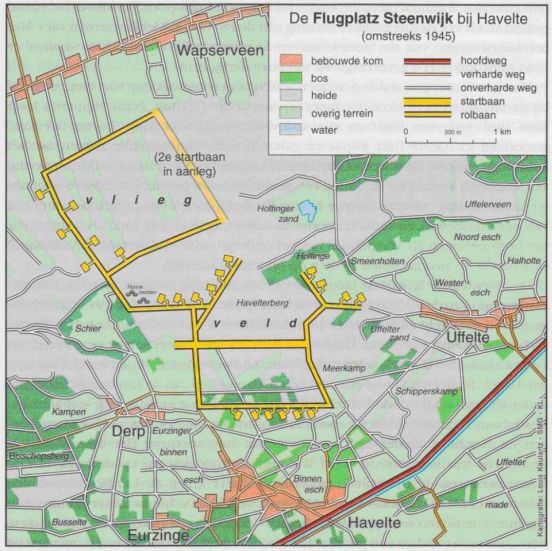 Another illustration. Startbaan=runway, rolbaan=rollbahn. 22 Hangars are plain to see. The second runway (2e startbaan) is under construction.
Another illustration. Startbaan=runway, rolbaan=rollbahn. 22 Hangars are plain to see. The second runway (2e startbaan) is under construction. 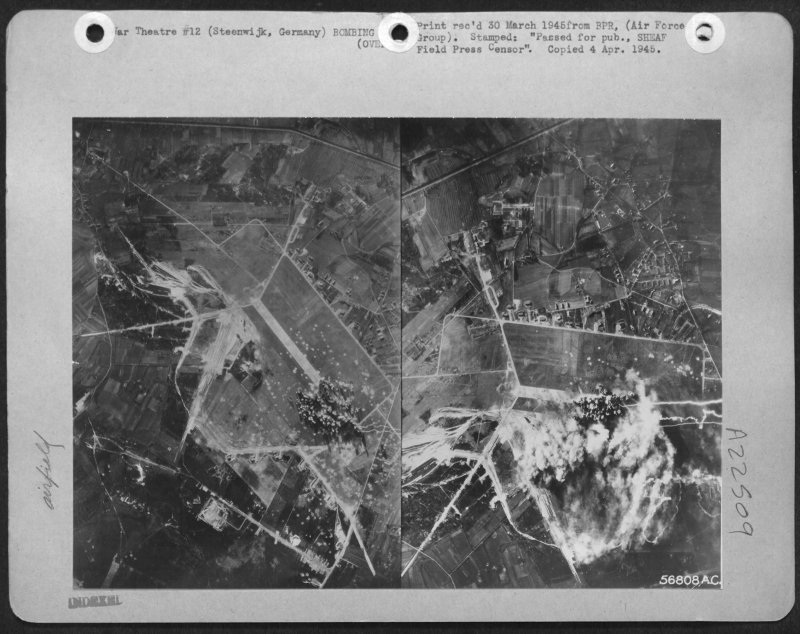 Airphoto, taken during the bombardment of 24 March 1945. The bombs hit the western end of the runway, which runs from West to East. There is a South wind. Source: Fold3.
Airphoto, taken during the bombardment of 24 March 1945. The bombs hit the western end of the runway, which runs from West to East. There is a South wind. Source: Fold3.Liberation and aftermath
On 13 April, 1945 Steenwijk and Havelte were liberated by Canadian troops. The retreating Germans blew up tens of objects on the airfield before they finally left. The ammunition storage of the airbase,the Munitions Ausgabe Stelle on the "De Eese" estate with 14 ammunition bunkers behind barbed wire entanglements of meters high was blown up on that same 13 April 1945.
After the war the twenty million bricks were transported to the west of the country, the Randstad, for the rebuilding effort. Some airplane wrecks remained behind. On a post war picture the tail of a Junkers 88 can be seen. Later the metal was sold as scrap metal. The last bombs were cleared in the beginning of the 90's of last century. The hunebedden, the heath and forest,have regained their original status. Only names like "startbaan" and" hangar pad" still betray the role of the war here. The taxi ways have become sand paths or normal roads. The runway is overgrown with trees and groves and can be easily identified on google earth. Between the forests and the heath hundreds of bomb craters can be discerned.
The area is remote but has good connections and can be well secured. Maybe this is the reason why NATO had a heavily guarded nuclear site for the warheads from the Honest John and Lance missiles. The site Havelterberg has served, between 1961 and 1992, as NATO depot for nuclear munition. The site was regularly the scene of demonstrations against nuclear arms. Nowadays the only remnant of the site is a watch tower; the bunkers, the entanglements and the communication equipment were all broken down and discarded.The site can be discerned on google earth as well.In the vicinity is a practice area that belongs to the post war Johannes Post barracks that is still in use with the Dutch army.
Images
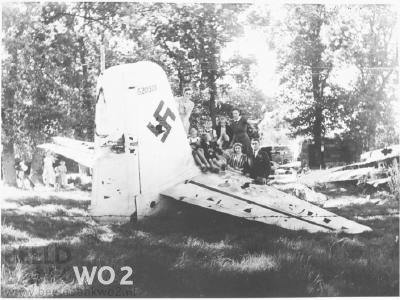 Airplane graveyard Havelte. Citizens posing in front of the wreck of a German aircraft. Source: Beeldbank WO2.
Airplane graveyard Havelte. Citizens posing in front of the wreck of a German aircraft. Source: Beeldbank WO2.Timeline Flugplatz Havelte
October, 1942
Decision for the construction of airfield Havelte. Peest was a failure because of high ground water levels. A fourth airfield is needed for the Nachtjagd next to Schiphol, Leeuwarden and Twente. Havelte lay favourable to these three.
20 november 1942
Bauleitung Steenwijk resides in Overcinge estate.
1943
Around 1,500 to 2,000 labourers are deployed.
End 1943, beginning 1944
RAD barrack camp on the terrain. 100 Germans of the Reichs Arbeits Dienst, the Labour Service.
From November 1943, turf is being brought up by requisitioned horse and waggon.
December 1943
Startbahn I got ready. The runway is 1,400 meters long and 80 meters wide.
11 January 1944
Three German fighters land for fuel and repairs.
Beginning of February 1944
Use of the Flugplatz.
Report resistance: Havelte is used as fallback and emergency field. No permanente units.
Detainees of the Rijkswerkinrichting in Veenhuizen and Groningen are put to work. Razzias in Steenwijk, Meppel and the surrounding area.
March 1944
Jews from mixed marriages and their sons are put to work. 500 of them are quartered in a camp north of the Hunebeddenweg.
April 1944
5,600 workers work on the Flugplatz.
23 April 1944
American fighter planes shoot at the labour camps. N. Stiel, a Jewish detainee, is killed.
8 May 1944
B-17G is damaged by Flak, touches down and explodes on the Eursinger Es, all ten crewmembers die.
May and June 1944
7./NJG.1 operates from the airfield.
Before 15 Augustus 1944
Luftwaffe detaches, in precaution, 13 Bf 110’s from 2./NJG 1 on Havelte (from Eelde).
15 August 1944
Air battle over Drenthe. Twenty Bf109 G6’s from 3./JG53 and 2./JG5 surprise returning Liberators from the 466th Bomb Group that are initially without fighter- escorts.
4 B-24H’s crash or explode in the air.
Two Lightnings crash.
The Luftwaffe loses at least five Bf 109’s.
B-24H "No Feathered Engines", ( F.Gerritz on board), 4 killed. Exploded in the air.
B-24H "Lady Lightning", 5 killed. Crashes near Nijetrijne.
B-24H "True Love", H.A. Clark on board, shoots down two Bf 109’s. Explodes in the air. Remains land in the Verlaatse polder south of Zuidveen. 5 killed.
B-24H "Stardust". On board Larry H. Clark. The Stardust shoots down two Germans.
B-24H "Ramblin’ Wreck I", with R. G. Borst on board, 3 killed,3 wounded that later died, 4 others, crashed in Gelderingen.
P-38J15/434th Fighter squadron/ Second Lieutenant L. Wallace dies through Flakbeschuss, anti aircraft fire. Crashed at Uffelte.
According to the German after action report two more Lightnings are shot and burned. One crashed in Zuidwolde.
Leutnant Ernst Scheufele, Staffelkapitän 6./JG 5 lands his Bf109 on the airfield of Havelte and just manages to escape the fire of the Lightnings. He later returns to his homebase Sachau.
Bf109 plows into the peatland at Nijensleek. Unteroffizier Rudolf Schierhofer, 21 years old, ejected but breaks a leg.
Bf109 crashed near Doldersum/Bosschoord. Oberfähnrich Horst Starzinski, 21 years, manages to eject from the plane before the crash but dies because of a failing parachute.
Bf109 crashes between Diever and Dwingeloo.
Bf109 crashes on the Oosteinde at Ruinerwold.
Bf109 crashes in Benderse near Ruinen.
End of Augustus 1944
MAST (Munition Ausgabe Stelle) Friesland, the ammunition depot for the airfield, is finished in the woods north of Steenwijk on the Eese estate.
26 August 1944 until 11 September 1944
4./NJG 1 with Bf110’s under Oberleutnant F.Lau in Havelte.
1 September 1944 until 17 September 1944
6./NJG 1 with Bf 110’s under Oberleutnant J.Hager in Havelte.
September 1944
Mosquitoes attack Havelte at least ten times. Climax in the night of 4 to 5 September, when 14 Mosquitoes drop 8 tons of high explosive bombs.
Night 16 on 17 September 1944
Fifty Lancasters and five Mosquitoes drop 222 tons of high explosive bombs. The payload falls mostly on the north-western side of the airfield.
12 October 1944
Me 262 piloted by Oberleutnant P.Bley from 1./Kommando Nowotny makes a forced landing on Havelte. Nosewheel broken off.
1 January 1945
German document reports of a Rollfeld from 1,200 meters long and 750 meters wide.
February 1945
Luftwaffe expands airfield in a northern direction.
Night of 3 on 4 March 1945 Havelte opened for 15 Ju 88s from 3./NJG 4. They are part of operation Gisela, returning British bombers are followed to their bases.Gisela is only moderately successful. 4 Ju 88s are destroyed, 4 Ju 88s are damaged, 1 Ju 88 lies crushed on the runway. One pilot dies.
23 March 1945
Fourteen Typhoons from the 197th and 266th Squadron strafe and bomb the seemingly empty airfield of Havelte.
24 March 1945
In total, 114 B-17G’s from 95th,100th en 390th Bomb Groups (Heavy) drop 271 tons of high explosive bombs on the airfield. The runway is totally obliterated. The western part of the airfield is heavily damaged. Repair- and construction activities continue. Resistance recommends another bombardment.
Around/before 27 March 1945
Nachtschlachtgruppe 20 (NSGR.20) returns to Eelde. Before it was detached on Soesterberg and Havelte. It flew with Focke-Wulf 190F or G’s.
7 April 1945
Spitfire IX/345th Squadron/ First Lieutenant R.M.F. Picot de Moras d’Aligny dies. He is shot down by Flak.
9 t/m 12 april 1945
Objects, bunkers and buildings of the airfield and the MAST Friesland were blown up by retreating Germans.
13 april 1945
Steenwijk and Havelte were liberated by the Canadians.
Fliegerhorstkommandanturen
| Fl.H.Kdtr.E 29/VI | from May, 1942 until May 1944. |
| Fl.H.Kdtr.E (v) | from May, 1944 until August 1944. |
| Fl.H.Kdtr.E (v) 235/XI | from August, 1944 until March 1945. |
E stands for Einsatzhafen for Kampf-, Sturzkampf- and Zerstörerverbände.
(v) stands for verlegbar, transportable, but without own organic transport.
XI stands for Luftgau XI Hannover.
Flak units in Havelte:
Flak Abteilung 552(v)Leichte Flak Abteilung 845 (v), both ressorting under Flakregiment 111 from Flakgruppe Amsterdam.
Definitielijst
- Abteilung
- Usually part of a Regiment and consisting of several companies. The smallest unit that could operate independently and maintain itself. In theory an Abteilung comprised 500-1,000 men.
- Flak
- Flieger-/Flugabwehrkanone. German anti-aircraft guns.
- Jews
- Middle Eastern people with own religion that lived in Palestine. They distinguished themselves by their strong monotheism and the strict observance of the Law and tradition. During World War 2 the Jewish people were ruthlessly persecuted and annihilated by the German Nazis. . An estimated 6,000,000 Jews were exterminated.
- Luftwaffe
- German air force.
- resistance
- Resistance against the enemy. Often also with armed resources.
- squadron
- A military unit in the Belgian navy usually six to eight small ships operating together under one command. The smallest military unit in the Dutch air force of about 350 men. In most countries is the designation of a military unit thesize of a company. It is either an independent unit, such as a battery, or part of a bigger Calvary unit. In the air force it is the designation of a unit of aircrafts.
Information
- Article by:
- Peter ter Haar
- Translated by:
- Peter ter Haar
- Published on:
- 19-01-2025
- Feedback?
- Send it!
Related sights
Sources
- CORNELISSEN, C. e.a., Vliegvelden in oorlogstijd, Boom, Amsterdam, 2009.
- SPREEN, H., Steenwijk in 40-45, Hovens-Gréve, Steenwijk, 1995.
- Lexikon der Wehrmacht
- De site van Ab Logtmeijer
- Drenthe in oorlog
- Diverse wikipedia artikelen o.a. me-109, lancaster.
- Lezing Johan Doeven en Jelle Kootstra.
- Fietsexcursie Johan Doeven van de Historische vereniging Steenwijk.
- Diverse krantenartikelen.

